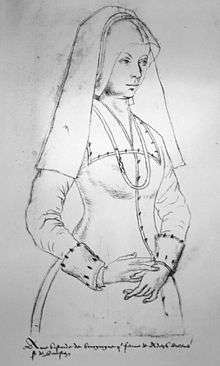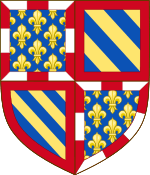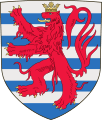Philip the Good
| Philip the Good | |
|---|---|
 Philip the Good, wearing the collar of firesteels of the Order of the Golden Fleece he instituted, copy of a Rogier van der Weyden of c.1450 | |
| Duke of Burgundy | |
| Reign | 10 September 1419 – 15 June 1467 |
| Predecessor | John the Fearless |
| Successor | Charles the Bold |
| Born |
31 July 1396 Dijon, Duchy of Burgundy |
| Died |
15 June 1467 (aged 70) Bruges, Flanders, Burgundian Netherlands |
| Burial | Dijon, Burgundy |
| Spouse |
Michelle of Valois Bonne of Artois Isabella of Portugal |
| Issue |
Charles the Bold David of Burgundy Anthony, bastard of Burgundy Anne of Burgundy |
| House | Valois-Burgundy |
| Father | John the Fearless |
| Mother | Margaret of Bavaria |


Philip the Good (French: Philippe le Bon, Dutch: Filips de Goede; 31 July 1396 – 15 June 1467) was Duke of Burgundy as Philip III from 1419 until his death. He was a member of a cadet line of the Valois dynasty, to which all the 15th-century kings of France belonged. During his reign, Burgundy reached the apex of its prosperity and prestige and became a leading center of the arts. Philip is known in history for his administrative reforms, his patronage of Flemish artists such as Jan van Eyck and Franco-Flemish composers such as Gilles Binchois, and the capture of Joan of Arc. In political affairs, he alternated between alliances with the English and the French in an attempt to improve his dynasty's position. As ruler of Flanders, Brabant, Limburg, Artois, Hainaut, Holland, Zeeland, Friesland and Namur, he played an important role in the history of the Low Countries.
Family and early life

Born in 1396 in Dijon, Philip was the son of John the Fearless and Margaret of Bavaria-Straubing.[1] His father succeeded Philip's grandfather Philip the Bold as Duke of Burgundy in 1404.[2] On 28 January 1405, Philip was named Count of Charolais in appanage of the duke and probably became engaged on the same day, at the age of 8, to Michele of Valois, a daughter of King Charles VI of France and Isabeau of Bavaria. They were married in June 1409.[3]
After Michelle's death in 1422, Philip married Bonne of Artois,[3] a daughter of Philip of Artois, Count of Eu, and also the widow of his uncle, Philip II, Count of Nevers, in Moulins-les-Engelbert on 30 November 1424. Bonne of Artois is sometimes confused with Philip's biological aunt, also named Bonne (a sister of John the Fearless who lived from 1379 to 1399), in part due to the papal dispensation required for the marriage, which made no distinction between a marital aunt and a biological aunt. Bonne of Artois lived only a year after Philip married her.
Philip was married for a third time to Isabella of Portugal, a daughter of John I of Portugal and Philippa of Lancaster, in Bruges on 7 January 1430.[4] This marriage produced three sons:[5]
- Anthony (September 30, 1430, Brussels – February 5, 1432, Brussels), Count of Charolais;
- Josse (April 24, 1432 – aft. May 6, 1432), Count of Charolais;
- Charles (1433–1477), Count of Charolais and Philip's successor as Duke of Burgundy, known as "Charles the Bold" or "Charles the Rash"[6]
Philip also had at least eighteen illegitimate children by various of his 24 documented mistresses, of which these are the best known:
- Corneille of Burgundy (c. 1420 – 1452), captain-general/governor of Luxembourg,[7] killed in the Battle of Bazel (1452);
- Anthony, bastard of Burgundy (1421–1504), lord of La Roche, Sainte-Menehould, Guînes, Lord of Crèvecoeur and Beveren;
- David of Burgundy (c. 1427 – 1496),[8] bishop of Therouanne and bishop of Utrecht,[9] a fine amateur artist, and the subject of a biography in 1529;
- Anne of Burgundy (c. 1435 – 1508), governess of Mary of Burgundy, married Adrian of Borssele and later Adolph of Cleves, Lord of Ravenstein;
- Raphaël of Burgundy, also called Raphaël de Marcatellis (c. 1437 – 1508), abbot of the Saint-Bavo Abbey in Ghent and the Saint-Peter Abbey in Oudenburg;
- Baldwin of Burgundy (c. 1446 – 1508), Lord of Fallais, Peer, Boudour, Sint-Annaland, Lovendegem, Zomergem en Fromont;
- Philip of Burgundy (1464–1524), Bishop of Utrecht.
Corneille and Anthony were his favorite bastard sons and successively bore the title Grand bâtard de Bourgogne (first Corneille and after his death, Anthony).
 Anthony of Burgundy
Anthony of Burgundy David of Burgundy
David of Burgundy Anne of Burgundy
Anne of Burgundy Portrait of a Lady, sometimes identified as Marie de Valengin, bastard daughter of Philip III, Duke of Burgundy, Washington DC National Portrait Gallery
Portrait of a Lady, sometimes identified as Marie de Valengin, bastard daughter of Philip III, Duke of Burgundy, Washington DC National Portrait Gallery.jpg) Philip of Burgundy
Philip of Burgundy
Early rule and alliance with England
Philip became duke of Burgundy and count of Flanders, Artois and Franche-Comté upon the assassination of his father in 1419.[10] Philip accused Charles, the Dauphin of France and Philip's brother-in-law, of planning the murder of his father, which took place during a meeting between John and Charles at Montereau. Because of this, he continued to prosecute the civil war between the Burgundians and Armagnacs. In 1420, Philip allied himself with Henry V of England under the Treaty of Troyes. In 1423, the marriage of Philip's sister Anne to John, Duke of Bedford, regent for Henry VI of England (and also his uncle), strengthened the English alliance.
On 23 May 1430, Philip's troops captured Joan of Arc at Compiègne[11] and later sold her to the English,[12] who orchestrated a heresy trial against her conducted by pro-Burgundian clerics. Despite this action against Joan of Arc, Philip's alliance with England was broken in 1435 when he signed the Treaty of Arras, which completely revoked the Treaty of Troyes and recognised Charles VII as king of France. Philip signed the treaty for a variety of reasons, one of which may have been a desire to be recognised as the preeminent duke in France. He then attacked Calais, a possession of the English, but the alliance with Charles was broken in 1439. Philip supported the revolt of the French nobles the following year (an event known as the Praguerie) and offered shelter to the Dauphin Louis, who had rebelled against his father Charles VII.
Geographic expansion
Philip was generally preoccupied with matters in his own territories and was seldom involved directly in the Hundred Years' War between England and France, although he did play a role during a number of periods, such as the campaign against Compiègne during which his troops captured Joan of Arc. He incorporated Namur into Burgundian territory in 1429 (by purchase from John III, Marquis of Namur) and Hainault and Holland, Friesland and Zeeland in 1432 with the defeat of Jacqueline, Countess of Hainault, in the last episode of the Hook and Cod wars. He inherited the Duchies of Brabant and Limburg and the Margraviate of Antwerp in 1430 on the death of his cousin Philip of Saint-Pol and purchased Luxembourg in 1443 from Elisabeth of Bohemia, Duchess of Luxembourg.
In 1456, Philip also managed to ensure his illegitimate son David was elected Bishop of Utrecht and his nephew Louis of Bourbon elected Prince-Bishop of Liège.
It is not surprising that in 1435 Philip began to style himself the "Grand Duke of the West".
In 1463, Philip gave up some of his territory to King Louis XI of France. That year he also created an Estates-General for the Netherlands based on the French model. The first meeting of the Estates-General was to obtain a loan for a war against France and to ensure support for the succession of his son Charles I to his dominions. In 1465 and 1467, Philip crushed two rebellions in Liège.
Philip died in Bruges in 1467.
Court life and patron of the arts

Philip's court can only be described as extravagant. Despite the flourishing bourgeois culture of Burgundy, with which the court kept in close touch, he and the aristocrats who formed most of his inner circle retained a world-view dominated by knightly chivalry. He declined membership in the English Order of the Garter in 1422, which could have been considered an act of treason against the king of France, his feudal overlord. Instead, he created his own Order of the Golden Fleece, based on the Knights of the Round Table and the myth of Jason, in 1430.
Philip had no fixed capital and moved the court between various palaces, the main urban ones being Brussels, Bruges, and Lille. He held grand feasts and other festivities, and the knights of his Order frequently travelled throughout his territory to participate in tournaments. In 1454, Philip planned a crusade against the Ottoman Empire, launching it at the Feast of the Pheasant, but this plan never materialized. In a period from 1444 to 1446, he is estimated to have spent a sum equivalent to 2% of Burgundy's main tax income in the recette génerale, with a single Italian supplier of silk and cloth of gold, Giovanni di Arrigo Arnolfini.[13]

Philip's court was regarded as the most splendid in Europe, and it became the accepted leader of taste and fashion, which probably helped the Burgundian economy considerably, as Burgundian (usually Flemish) luxury products became sought by the elites of other parts of Europe. During his reign, for example, the richest English commissioners of illuminated manuscripts moved away from English and Parisian products to those of the Netherlands, as did other foreign buyers. Philip himself is estimated to have added six hundred manuscripts to the ducal collection, making him by a considerable margin the most important patron of the period.[14] Jean Miélot was one of his secretaries, translating into French such works as Giovanni Bocaccio's Genealogia Deorum Gentilium.
Philip was also a considerable patron of other arts. He commissioned many tapestries (which he tended to prefer over paintings), pieces from goldsmiths, jewellery, and other works of art. It was during his reign that the Burgundian chapel became the musical center of Europe, with the activity of the Burgundian School of composers and singers. Gilles Binchois, Robert Morton, and later Guillaume Dufay, one of the most prominent composers of the 15th century, were all part of Philip's court chapel.
In 1428, Jan van Eyck traveled to Portugal to paint a portrait of the daughter of King John I, the Infanta Isabella, for Philip in advance of their marriage. With help from more experienced Portuguese shipbuilders, Philip established a shipyard in Bruges.
Rogier van der Weyden painted his portrait twice on panel, of which only copies survive, wearing the collar of the Order of the Golden Fleece. The only original van der Weyden of Philip to survive is a superb miniature from a manuscript (above left).[14] The painter Hugo van der Goes of the Early Netherlandish school is credited with creating paintings for the church where Philip's funeral was held.
Honours
-
 Duchy of Burgundy : 1st Grand Master and Knight of the Order of the Golden Fleece
Duchy of Burgundy : 1st Grand Master and Knight of the Order of the Golden Fleece -
.svg.png) Kingdom of France – Duchy of Orléans : Knight of the Order of the Porcupine
Kingdom of France – Duchy of Orléans : Knight of the Order of the Porcupine
Refused honours
-
 Kingdom of England : He refused the Order of the Garter
Kingdom of England : He refused the Order of the Garter
Ancestry
| Ancestors of Philip the Good | ||||||||||||||||||||||||||||||||||||||||||||||||||||||||||||||||||||||||||||||||||||||||||||||||||||||||||||||||||||||||||||||||||||||||||||||||||||||||||||||||||||||||||||||||||||||||||||||||||||||||||||||||||||||||||||||||||||||||||||||||||||||||||||||||||||||||||||||||||||||||||||||||||||||||||||||||||||||||||||||||||||||||||||||||||
|---|---|---|---|---|---|---|---|---|---|---|---|---|---|---|---|---|---|---|---|---|---|---|---|---|---|---|---|---|---|---|---|---|---|---|---|---|---|---|---|---|---|---|---|---|---|---|---|---|---|---|---|---|---|---|---|---|---|---|---|---|---|---|---|---|---|---|---|---|---|---|---|---|---|---|---|---|---|---|---|---|---|---|---|---|---|---|---|---|---|---|---|---|---|---|---|---|---|---|---|---|---|---|---|---|---|---|---|---|---|---|---|---|---|---|---|---|---|---|---|---|---|---|---|---|---|---|---|---|---|---|---|---|---|---|---|---|---|---|---|---|---|---|---|---|---|---|---|---|---|---|---|---|---|---|---|---|---|---|---|---|---|---|---|---|---|---|---|---|---|---|---|---|---|---|---|---|---|---|---|---|---|---|---|---|---|---|---|---|---|---|---|---|---|---|---|---|---|---|---|---|---|---|---|---|---|---|---|---|---|---|---|---|---|---|---|---|---|---|---|---|---|---|---|---|---|---|---|---|---|---|---|---|---|---|---|---|---|---|---|---|---|---|---|---|---|---|---|---|---|---|---|---|---|---|---|---|---|---|---|---|---|---|---|---|---|---|---|---|---|---|---|---|---|---|---|---|---|---|---|---|---|---|---|---|---|---|---|---|---|---|---|---|---|---|---|---|---|---|---|---|---|---|---|---|---|---|---|---|---|---|---|---|---|---|---|---|---|---|---|---|---|---|---|---|---|---|---|---|---|---|---|---|---|---|---|---|---|---|
| ||||||||||||||||||||||||||||||||||||||||||||||||||||||||||||||||||||||||||||||||||||||||||||||||||||||||||||||||||||||||||||||||||||||||||||||||||||||||||||||||||||||||||||||||||||||||||||||||||||||||||||||||||||||||||||||||||||||||||||||||||||||||||||||||||||||||||||||||||||||||||||||||||||||||||||||||||||||||||||||||||||||||||||||||||
See also
References
- ↑ Richard Vaughan, John the Fearless: The Growth of Burgundian Power, (The Boydell Press, 2010), 2.
- ↑ Richard Vaughan, John the Fearless: The Growth of Burgundian Power, 4, 6.
- 1 2 Richard Vaughan, Philip the Good: The Apogee of Burgundy, (The Boydell Press, 2010), 8.
- ↑ Willem Pieter Blockmans and Walter Prevenier, The Promised Lands: The Low Countries under Burgundian Rule, 1369–1530, (University of Pennsylvania Press, 1999), 73.
- ↑ Richard Vaughan, Philip the Good: The Apogee of Burgundy, 132.
- ↑ Willem Pieter Blockmans and Walter Prevenier, The Promised Lands: The Low Countries under Burgundian Rule, 1369–1530, 73.
- ↑ Richard Vaughan, Philip the Good: The Apogee of Burgundy, 196.
- ↑ Richard Vaughan, Philip the Good: The Apogee of Burgundy, 227.
- ↑ Ruth Putnam, Charles the Bold, last Duke of Burgundy, 1433–1477, (G.P. Putnam's Sons, 1908), 69–71.
- ↑ Richard Vaughan, Philip the Good: The Apogee of Burgundy, 1.
- ↑ Malcolm Graham Allan Vale, Charles the Seventh, (University of California Press, 1974), 58.
- ↑ Alexander Gillespie, The Causes of War: Volume III: 1400 CE to 1650 CE, Vol. III, (Hart Publishing, 2017), 15.
- ↑ National Gallery Catalogues: The Fifteenth Century Netherlandish Paintings by Lorne Campbell, 1998, ISBN 1-85709-171-X
- 1 2 T Kren & S McKendrick (eds), Illuminating the Renaissance: The Triumph of Flemish Manuscript Painting in Europe, Getty Museum / Royal Academy of Arts, 2003, p. 68, ISBN 1-903973-28-7
External links
| Wikisource has the text of the 1911 Encyclopædia Britannica article Burgundy. |
| Wikimedia Commons has media related to Philip III Duke of Burgundy. |
- Brief Profile – Contains a short biography of Philip, from "The Best of Dijon".
- EHistory page – Short sketch of the Duke's life, from E-History.com.
- Joan of Arc's First Letter to Philip – Mention of a letter dictated by Joan of Arc to Duke Philip in June 1429, translated by Allen Williamson.
- Joan of Arc's Second Letter to Philip – Translation by Allen Williamson of a letter dictated by Joan of Arc to Duke Philip on 17 July 1429.
- Philip III – Article from the Web Gallery of Art.
- Philip the Good in the 1911 Encyclopædia Britannica at 1911encyclopedia.org
- Burgundy in the 1913 Catholic Encyclopedia at NewAdvent.org
| Philip the Good Cadet branch of the House of Valois Born: 31 July 1396 Died: 15 June 1467 | ||
| Preceded by John the Fearless |
Duke of Burgundy Count of Artois and Flanders Count Palatine of Burgundy 10 September 1419 – 15 July 1467 |
Succeeded by Charles the Bold |
| Count of Charolais 28 January 1405 – November 1433 | ||
| Preceded by John III |
Margrave of Namur 1 March 1429 – 15 July 1467 | |
| Preceded by Philip I |
Duke of Brabant, Limburg and Lothier 14 August 1430 – 15 July 1467 | |
| Preceded by Jacqueline |
Count of Hainaut, Holland and Zeeland April 1432 – 15 July 1467 | |
| Preceded by Elisabeth |
Duke of Luxemburg 1443 – 15 July 1467 | |



